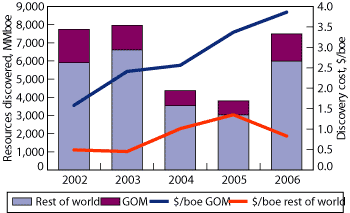Deepwater Statistical Report
Alison Sheppard, Wood Mackenzie Since 2002, over 30 billion boe have been discovered in global deepwater basins, with an average resource size of around 110 MMboe. But, with the exception of 2006 when a number of large discoveries were made, reserves discovered and the average size of discoveries have been decreasing, while finding costs have been steadily rising; thanks to tight rig availability, rocketing day rates and personnel shortages.
The Big Four deepwater provinces (Angola, Nigeria Brazil, and Gulf of Mexico) have continued to dominate deepwater exploration over the past five years, but both Angola and Nigeria have been hit by declining discovery sizes. Brazil’s 2006 results were boosted by two +500 MMboe discoveries, including the Tupi field in which BG partnered with Petrobras. Tupi is the first potentially commercial discovery in a significant new sub-salt play.
 |
Reserves discovered have been decreasing, while finding
costs have been steadily rising, except for 2006 when a
number of large discoveries were made.
|
|
GOM exploration has continued at a steady pace since 2002, despite average discovery sizes declining to around 50 MMboe in 2005. At the same time, the region, which was already seen as a high cost area, has experienced a near doubling of finding costs through the period. Despite this, GOM is still a key region in global deepwater exploration, backed up by the emerging Lower Tertiary play. The 2006 Kaskida discovery is believed to be the largest Lower Tertiary find to date with estimated recoverable resources in excess of 400 MMboe.
With declining pool sizes in the Big Four, companies are looking to new deepwater frontier basin. China and Australia, in particular, are rising stars in deepwater gas exploration.
The pace of deepwater exploration offshore western Australia has increased rapidly, driven by increased demand for LNG projects. To date, only a small proportion of the area has been explored, yet 2006 saw 10 Tcf of technical gas reserves (1,850 MMboe) added to the Greater Gorgon area. During 2006, a potential 5 Tcf (880 MMboe) gas field was discovered in China’s Pearl River Mouth basin. These significant discoveries have helped offset the increasing finding-cost trend in global deepwater regions. 
|



